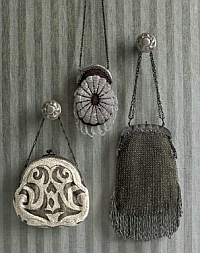
 Go Back
Go Back

Vintage Evening Bags
Produced by Sharon Graber and styled by
Shelly Coon
 Collectible vintage evening bags can
be found in a variety of styles, materials, and sizes--learn all about
about their interesting history and their value.
Collectible vintage evening bags can
be found in a variety of styles, materials, and sizes--learn all about
about their interesting history and their value.
In days long past, the fate of women's purses depended quite literally
on their pockets. During the early 1800s, when the slim silhouette and
delicate fabrics of the Empire style offered no concession to pockets,
one's personal sundries were stashed in a cord-handled pouch called a
reticule. By the 1840s, however, reaction against this brief respite
from female confinement set in with a vengeance. Corsets came back.
Skirts expanded. And to some extent, the reticule waned in popularity as
pockets were once again feasible.
Then, around 1912, couture kingpin Paul Poiret shackled women's legs
with the hobble skirt, thus bringing purses back to the forefront. And
there, despite ensuing fashion vagaries, they've remained ever since. As
both necessity and accessory, purses--especially those for evening
wear--had now become indispensible.
From the artisans' perspective, that very feminine object known as the
evening bag presented a vast scope of creative possibilities. Today, we
can appreciate their triumph in the craftsmanship of meticulously beaded
reticules and in handbags fashioned from sensuous satins, rich
brocades, and luxurious golden mesh. We see it, too, in the fine
detailing of a faux-jeweled frame, or the stitched hand strap on the
back of a silk moire clutch.
Why were some of these bags so small? For the Victorian lady--her face
innocent of makeup, her contours cinched to swooning point--the tiny
reticule she carried was perfectly sized for her needs. To wit: a hanky,
a coin purse, and maybe a vial of sal volatile to fend off the
odd fainting spell. Gradually, makeup became more acceptable and by the
late 1920s, liberated women added powder compacts, lip rouge, combs, and
mirrors to the mix, and purses grew accordingly. By the '40s, we begin
to see exquisite little compacts and other accessories included by the
bags' makers.
For the modern collector, some of these evocative keepsakes forge
connections to a distant age of dinners à la russe, cotillions, nights
at the opera. Other evening bags may conjure the eras of speakeasies and
supper clubs where, it's tempting to imagine, the bags' original owners
abandoned themselves to the tango, or fell in love to the orchestral
strains of Gershwin and Porter. Ah, the wonders there are in a woman's
purse.
"Vintage bags are highly collectible," says Ronna Lee Aikins, who owns
Ronna Lee's Vintage & Vogue in Indiana, Pa. "And values depend on
condition, design, size, and origin. Most bags range from $100 to $400,
but prices are rising. Recently, a metal mesh bag sold for $7,200."
What makes it an evening bag? "I call it the sparkle factor,"
says Pennsylvania-based antiques dealer and collector Laura Brehmer of
The Cats Pajamas. "It's the glitter of glass beads, or rhinestones, or
gold lame. Today, fashion is so eclectic that it's not unusual to see
dressy vintage bags being worn with jeans. But back in the day, sparkle
belonged to the evening hours."
Tips for preserving vintage bags: Wrap them in acid-free paper
(not plastic). Don't store bags in stacks (it can loosen beads). Keep
them in a dry place (steel and other metals can rust).
As Featured on
ArticleCity.com

